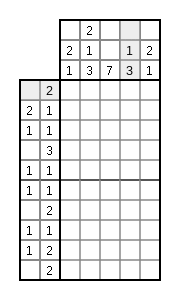Nonograms are also known by other names, including Paint by Numbers, Griddlers, Pic-a-Pix, Picross, PrismaPixels, Pixel Puzzles, Crucipixel, Edel, FigurePic, Grafilogika, Hanjie, Illust-Logic, and Japanese Crosswords. If you know how to play one of these, then the rules are the same!
The rules are simple.
Your aim in these puzzles is to colour the whole grid in to black and white squares or mark with X. Beside each row of the grid are listed the lengths of the runs of black squares on that row. Above each column are listed the lengths of the runs of black squares in that column.
These numbers tell you the runs of black squares in that row/column. So, if you see '10 1', that tells you that there will be a run of exactly 10 black squares, followed by one or more white square, followed by a single black square. There may be more white squares before/after this sequence. If you see 0 (zero) it means - "I'm not telling you how many squares", so a column/row can contain any number of squares or gaps.

Left click on a square to make it black. Right click to mark with X. Click and drag to mark more than one square.
Solution techniques
To solve a puzzle, one needs to determine which cells will be boxes and which will be empty. Determining which cells are to be left empty (called spaces) is as important as determining which to fill (called boxes). Later in the solving process, the spaces help determine where a clue (continuing block of boxes and a number in the legend) may spread. Solvers usually use a dot or a cross to mark cells they are certain are spaces.
It is also important never to guess. Only cells that can be determined by logic should be filled. If guessing, a single error can spread over the entire field and completely ruin the solution. It usually comes to the surface only after a while, when it is very difficult to correct the puzzle. Usually, only advanced and experienced solvers are able to fix it completely and finish such ruined puzzles.
The hidden picture plays no part in the solving process. Even if it is obvious from the picture that a cell will be a box, it is usually treacherous to rely on it. The picture, however, may help find and eliminate an error.
Simpler puzzles can usually be solved by a reasoning on a single row only (or a single column) at each given time, to determine as many boxes and spaces on that row as possible. Then trying another row (or column), until there are no rows that contain undetermined cells.
Some more difficult puzzles may also require several types of "what if?" reasoning that include more than one row (or column). This works on searching for contradictions: When a cell cannot be a box, because some other cell would produce an error, it will definitely be a space. And vice versa. Advanced solvers are sometimes able to search even deeper than into the first "what if?" reasoning. It takes, however, a lot of time to get some progress.